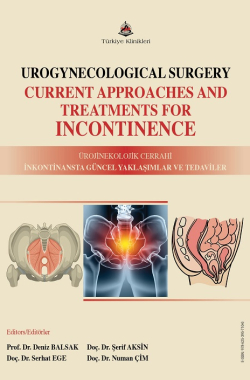SACROCOLPOPEXY
Zeynep Ömer
Bakırköy Dr. Sadi Konuk Training and Research Hospital, Department of Gynecology and Obstetrics, İstanbul, Türkiye
Ömer Z. Sacrocolpopexy. In: Balsak D, Çim N, Ege S editors. Urogynecological Surgery Current Approaches and Treatments for Incontinence. 1st ed. Ankara: Türkiye Klinikleri; 2025. p.219-224.
ABSTRACT
Pelvic organ prolapse is a quite common condition among women over a certain age that can be underestimated. It is a condition caused by the weakening and relaxation of the supportive muscles and connective tissues of the pelvic floor. There are many reasons that can lead to this weakness; among them are aging, pregnancy, childbirth, conditions that increase intra-abdominal pressure, chronic constipation, chronic cough, asthma, previous pelvic surgeries, and hysterectomy. Sacrocolpopexy is the gold standard surgical treatment in cases of apical prolapse. This operation done by fixing either the uterine cervix (sacrohysteropexy) or the vaginal apex (sacrocolpopexy in hysterectomised pateints) to a ligament infront of the sacral promontary called the anterior longitudinal ligament inorder to lift the vaginal apex to a higher level but in the same axis using a mesh which can be senthetic or biologic The basis of sacrocolpopexy is to anchor the vaginal apex to the anterior longitudinal ligament of the sacrum via a mesh. Sacrocolpopexy can be performed using different surgical procedures, including abdominal laparotomy or minimally invasive techniques (laparoscopic or robotic), as well as vaginal surgeries (vNOTES). Abdominal sacrocolpopexy is the gold standart surgical treatment for apical pelvic organ prolapsus. Minimally invasive techniques have increasingly replaced open surgery and recorded better results in terms of postoperative morbidity and patient recovery. In recent years, due to innovations in minimally invasive surgical techniques and instrumentation, along with the increasing experience of surgeons in this field, less invasive surgeries have become preferred. The results obtained from minimally invasive surgeries are at least as good as those from open surgeries, with less bleeding and shorter hospitalisation period. Therefore, laparoscopic or robotic sacrocolpopexy is becoming the primary treatment instead of laparotomic sacrocolpopexy. In sacrocolpopexy in addition to the general complications of surgery like the risks of anastesia, bleeding, infections, thromboembolism; there is the risk of mesh associated complications.
Keywords: Pelvic organ prolapsus; Sacrocolpopexy; Laparatomy; Laparoscopic; Robotic sacrocolpopexy;Vnotes
Kaynak Göster
Referanslar
- Lane FE. Repair of posthysterectomy vaginal-vault prolapse. Obstet Gynecol. 1962;20(1):72-7. [Crossref] [PubMed]
- Nosti PA, et al. Outcomes of abdominal and minimally inva sive sacrocolpopexy: a retrospective cohort study. Female Pelvic. Med Reconstr Surg 2014;20(1):33-37. [Crossref] [PubMed]
- Pan K, Zhang Y, Wang Y, Wang Y, Xu H. A systematic review and meta-analysis of conventional laparoscopic sacrocol popexy versus robot-assisted laparoscopic sacrocolpopexy. Int J Gynaecol Obstet 2016;132(3):284-291. [Crossref] [PubMed]
- McFerrin C, Pilkington JE, Pilet H, Frilot CF, Gomelsky A. Abdominal versus robotic sacral colpopexy: a detailed analysis of outcomes. Neurourol Urodyn. 2021;40(7):1811-1819. [Crossref] [PubMed]
- Brubaker L. Sacrocolpopexy and the anterior compartment: support and function. Am J Obstet Gynecol 1995;173:1690. [Crossref] [PubMed]
- Cundiff GW, Harris RL, Coates K, et al. Abdominal sacral colpoperineopexy: a new approach for correction of posterior compartment defects and perineal descent associated with vaginal vault prolapse. Am J Obstet Gynecol 1997;177:1345. [Crossref] [PubMed]
- Callewaert G et al. Laparoscopic versus robotic-assisted sacrocolpopexy for pelvic organ prolapse: a systematic review. Gynecol Surg. 2016;13:115-123. [Crossref] [PubMed] [PMC]
- Zhang Y, Jiang X, Mao M, Bai J, Tian Y, Sun W, Guo R. No Difference in Prolapse Recurrence Rates Between Laparoscopic and Robotic-Assisted Sacrocolpopexy: A Long-Term Comparison.J Minim Invasive Gynecol. 2025;32(5):447-453. [Crossref] [PubMed]
- Chloé Dehan, Sarah Marcelle, Michelle Nisolle, Carine Munaut, Laurent de Landsheere. Outcomes of Laparoscopic versus Robotic-Assisted Sacrocolpopexy for Pelvic Organ Prolapse-A Comprehensive Retrospective Analysis Int Urogynecol J. 2024;35(11):2203-2210. [Crossref] [PubMed]

